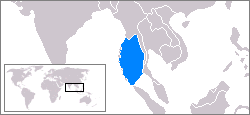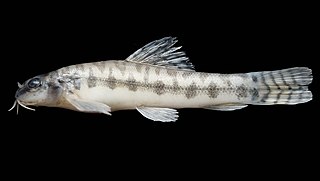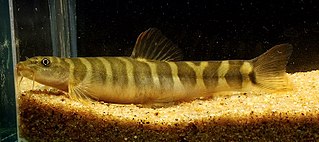
The Andaman Sea is a marginal sea of the northeastern Indian Ocean bounded by the coastlines of Myanmar and Thailand along the Gulf of Martaban and the west side of the Malay Peninsula, and separated from the Bay of Bengal to its west by the Andaman Islands and the Nicobar Islands. Its southern end is at Breueh Island just north of Sumatra, with the Strait of Malacca further southeast.

The Mekong or Mekong River is a trans-boundary river in East Asia and Southeast Asia. It is the world's twelfth-longest river and the third-longest in Asia with an estimated length of 4,909 km (3,050 mi) and a drainage area of 795,000 km2 (307,000 sq mi), discharging 475 km3 (114 cu mi) of water annually. From its headwaters in the Tibetan Plateau, the river runs through Southwest China, Myanmar, Laos, Thailand, Cambodia, and southern Vietnam. The extreme seasonal variations in flow and the presence of rapids and waterfalls in the Mekong make navigation difficult. Even so, the river is a major trade route between Tibet and Southeast Asia. The construction of hydroelectric dams along the Mekong in the 2000s through the 2020s has caused serious problems for the river's ecosystem, including the exacerbation of drought.

The Salween is a Southeast Asian river, about 3,289 km (2,044 mi) long, flowing from the Tibetan Plateau south into the Andaman Sea. The Salween flows primarily within southwest China and eastern Myanmar (Burma), with a short section forming the border of Burma and Thailand. Throughout most of its course, it runs swiftly through rugged mountain canyons. Despite the river's great length, only the last 90 km (56 mi) are navigable, where it forms a modest estuary and delta at Mawlamyine. The river is known by various names along its course, including the Thanlwin in Burma and the Nu Jiang in China. The commonly used spelling "Salween" is an anglicisation of the Burmese name dating from 19th-century British maps.

The Irrawaddy River is the largest river in Myanmar. Originating from the confluence of the N'mai and Mali rivers, it flows from north to south before emptying through the Irrawaddy Delta in the Ayeyarwady Region into the Andaman Sea. Its drainage basin of about 404,000 square kilometres (156,000 sq mi) covers 61% of the land area of Burma, and contains five of its largest cities.
Acanthocobitis is a genus of freshwater ray-finned fish of the stone loach family, Nemacheilidae. Recent work has suggested that the genus be split into two with the former subgenus Paracanthocobitis being raised to a full species, leaving just the type species, Acanthocobitis pavonacea, in the current genus.

Paracanthocobitis is a genus of freshwater ray-finned fishes belonging to the family Nemacheilidae, the stone loaches. This genus is known from the Indus basin in Pakistan to the Mekong basin of Cambodia and Laos The type species is Paracanthocobitis zonalternans. Some authorities treat this as a subgenus of Acanthocobitis

Paracanthocobitis mooreh also known as the Maharashtra zipper loach is a species of ray-finned fish in the genus Paracanthocobitis. This species is found in the Godavari, Krishna, and Kaveri basins of western and southern India.
Paracanthocobitis pictilis, also known as the Ataran zipper loach, is a species of ray-finned fish in the genus Paracanthocobitis. It is native to Myanmar and Thailand. It was described to science in 2012.

Paracanthocobitis urophthalma, also known as the banded mountain zipper loach, is a species of ray-finned fish in the genus Paracanthocobitis. This species is endemic to southwestern Sri Lanka.

Paracanthocobitis zonalternans also known as the dwarf zipper loach is a species of ray-finned fish in the genus Paracanthocobitis. This species is known from Bangladesh, Myanmar, Thailand, and peninsular Malaysia. It is found in the Brahmaputra, Meghna, Irrawaddy, Sittang, Salween, Maeklong, and drainages in peninsular Thailand and Malaysia. The range extends from northern Myanmar to peninsular Malaysia. It is not known from the Chao Phraya basin.
Paracanthocobitis abutwebi also known as the hillstream zipper loach is a species of ray-finned fish in the genus Paracanthocobitis. This species is known from the Karnaphuli, Meghna, and lower Brahmaputra and Ganges river drainages of Bangladesh.
Paracanthocobitis adelaideae also known as the checkerboard zipper loach is a species of ray-finned fish in the genus Paracanthocobitis. This species is known from the Irrawaddy basin of northern Myanmar.
Paracanthocobitis canicula also known as the houndstooth zipper loach is a species of ray-finned fish in the genus Paracanthocobitis. This species is known from the lower Mekong basin of Cambodia.
Paracanthocobitis linypha also known as the sewing needle zipper loach is a species of ray-finned fish in the genus Paracanthocobitis. This species is known from the Irrawaddy and Sittang basins in Myanmar.
Paracanthocobitis maekhlongensis also known as the Maekhlong zipper loach is a species of ray-finned fish in the genus Paracanthocobitis. This species is known from the Maeklong River basin, Kanchanaburi Province, Thailand.

Paracanthocobitis botia also known as the mottled zipper loach is a species of ray-finned fish in the genus Paracanthocobitis. This species is known from the mainstem, and possibly tributaries of the Brahmaputra River, in Assam, India.
Paracanthocobitis mackenziei also known as the robust zipper loach is a species of ray-finned fish in the genus Paracanthocobitis. This species is the most widely distributed species of Paracanthocobitis and is known from the Ganges River basin of Nepal and India, the Meghna River basin in Bangladesh, the Mahanadi River basin in eastern India, and the upper Indus River basin of northern India and eastern Pakistan. Fishbase treats P. (A). mackenziei under Nemachilus mackenziei as a synonym of Acnthocobitis botia.
Paracanthocobitis rubidipinnis also known as the cherryfin zipper loach is a species of ray-finned fish in the genus Paracanthocobitis. This species is known from the Irrawaddy basin in Myanmar.
Paracanthocobitis aurea also known as the barred zipper loach is a species of ray-finned fish in the genus Paracanthocobitis. This species is known only from the type locality, the Narmada River at Jabalpur, state of Madhya Pradesh, India.

Kyeintali is a town located in Gwa Township of Rakhine State, Myanmar (Burma).








